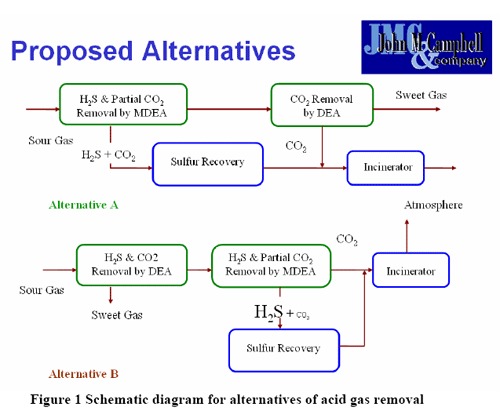In this Tip of the Month, we will study two alternatives for removal of H2S and CO2 from natural gas. The process objective is to produce a sweet gas with less than 4 PPM H2S and the near total removal of CO2due to the presence of a downstream nitrogen rejection unit (NRU). Each alternative consist of two stages of acid gas removal. The schematic diagrams for both alternatives are shown in Figure 1. The detail of gas sweetening may be found in the Gas Conditioning and Processing, Vol. 4, “Gas and Liquid Sweetening”.
In option A, sour natural gas is treated in the MDEA unit to selectively remove H2S and part of the CO2. The partially treated gas is then sent to the DEA unit for removal of the remaining CO2. The acid gas from the MDEA unit is sent to the sulfur recovery unit (SRU). The acid gas from the DEA unit, mainly CO2, and tail gas from the SRU are sent to the incinerator.
In the second alternative (Option B), all of the H2S and CO2 are removed in the DEA unit and sent to the MDEA unit where H2S is selectively removed at low pressure. The H2S enriched acid gas from the MDEA unit is sent to the SRU. The CO2 from the MDEA contactor is routed directly to the incinerator unit.
We performed rigorous computer simulation for both alternatives with typical process specifications. The simulation results showed that arrangement of the MDEA and DEA units and the order of their utilization make a difference in the concentration of H2S in the acid gases fed to the sulfur recovery unit. Our study indicated that option B produces richer H2S in the acid gases stream, producing a more suitable feed for sulfur recovery unit. A drastic reduction of pumping was obtained for option B. Smaller diameter and fewer number of trays for the contactor of the MDEA unit in Option B are needed. An additional benefit of option B is that less pick up of heavy hydrocarbons from the feed gas was obtained. This will benefit both the operation of the amine units and the SRU. The preliminary evaluation indicates that the overall energy consumption is lower for option B which has more favorable performance. However, for decision making process, a detail economic analysis for both options is highly recommended.






.jpg)


















.bmp)
























































.jpg)

